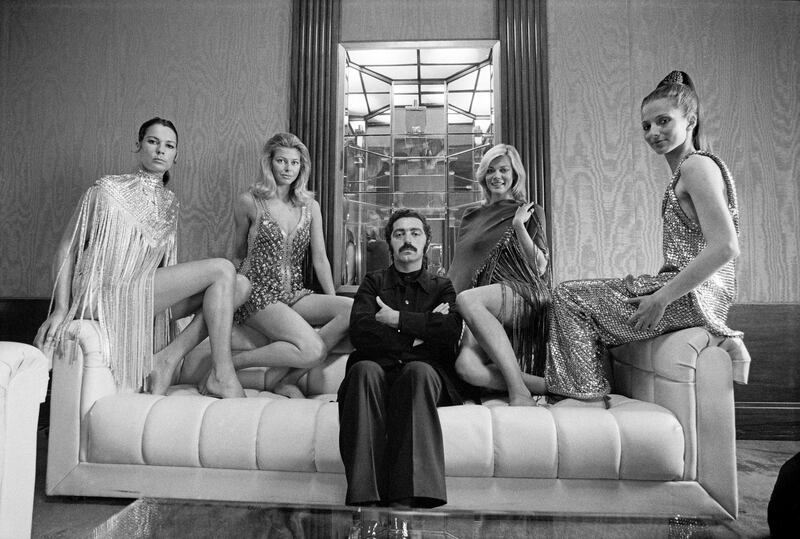Born: February 18th, 1934
Died: February 3rd, 2023
The 1966 Paris show of Paco Rabanne, who has died aged 88, was outrageous, and immediately set him together with André Courrèges as a designer of what was thought to be the future but turned out only to be a passing phase.
Rabanne called that debut collection Manifesto: 12 Unwearable Dresses in Contemporary Materials. He showed on both black and white models, who went barefoot because he could not afford to shoe them. They wore brief dresses assembled of plaques of metal or Rhodoid, an organic plastic, linked flexibly by wire ties. Paris fulminated. Gabrielle “Coco” Chanel said: “He’s a metalworker, not a couturier.” However New York, especially Vogue’s Diana Vreeland and the Herald Tribune’s Eugenia Sheppard, enjoyed the textile alternatives. The art collector Peggy Guggenheim bought and wore them.
RM Block
Rabanne had paid for years of architectural studies – he specialised in reinforced concrete construction – by making abstract jewellery and novelty buttons of metal, leather, even coffee beans for the houses of Schiaparelli (he retained for life her surrealist tastes), Dior, Balenciaga, Cardin and Givenchy. He also sketched for them and shoe designer Charles Jourdan, and, in the early 1960s, fabricated wild accessories for young, ready-to-wear designers such as Emmanuelle Khanh. That gave Rabanne a hands-on approach to fashion that did not involve cloth or sewing.
The 1966 show, which was early fashion performance art, stressed this radicalism, while his designs, later also in wood, mirror shards, and huge mother of pearl paillettes that tinkled like windchimes as their wearer moved, photographed well and got great coverage. So did his garments, sticky-taped or sealed together rather than seamed, in a new, nylon-fibre-strengthened paper. He produced hotel pyjamas in this and intended disposable dresses to be sold to frequent flyers from vending machines in the world’s expanding airports, but the merchandising never took off.
Rabanne then announced that his idea of the female was a warrior heroine, a Joan of Arc in want of armour, albeit to emphasise her torso’s sexuality. He had contributed a chic metal-paillette minidress to Audrey Hepburn’s first post-Givenchy wardrobe in the 1967 film comedy Two for the Road, and his martial pronouncement made him the only choice to costume Jane Fonda for the 1968 fantasy Barbarella.

For her, Rabanne used a less-riveted combination of PVC, leather, stretch jersey, fur, feathers, induction-moulded plastic bodyforms, and small areas of signature metal work. The outfits were personally torn and cut away by Fonda’s husband and director, Roger Vadim, and looked more Crazy Horse showgirl than sci-fi; Rabanne had once shown on the dancers at that cabaret. Yet they have had a lasting influence: female fantasy warrior women remain bare-necked and limbed in corset-shaped bodyforms with a touch of metal trim.
By the year of Barbarella, excitement in fashion was already moving from an imagined future to a bucolic, folkloric past that also never happened. Textiles, preferably muslin handblock-printed in India, were the new thing. Rabanne drifted away from being a top modist, although personal customers remained, especially musicians: Françoise Hardy wore gold and silver Rabanne on stage, despite plier adjustments being necessary between numbers. He followed what became the usual route for established Parisian designers – 140 licences granted to manufacturers, a ready-to- wear line for men in 1983, for women in 1990.
First fragrance
His real move ahead was to go into business with the Barcelona-based Puig family perfume company, which had opened a Paris office and backed him to launch his first fragrance, Calandre, in 1969. After Paco Rabanne Pour Homme in 1973, an enduring best-seller based on herbs and moss, Puig built a French factory that produced many of his perfumes and colognes, including the XS and Ultraviolet ranges, right up to 1 Million, 2008, the last scent that Rabanne helped develop himself. Puig also took over his fashion house in 1987; Rabanne retired from it in 1999.
[ Designer Paco Rabanne dies aged 88Opens in new window ]
That the family were from Catalonia had mattered to Rabanne. He was a Basque, born Francisco Rabaneda Cuervo, in Pasaia, near San Sebastián, the son of a colonel in the Republican army executed by Francoists during the Spanish civil war.

His mother had worked for Balenciaga’s original establishment in San Sebastián, perhaps why he described sewing as “slavery”. She fled with her mother, the boy, his brother and two sisters and they were among refugees camped near Guernica when the town was destroyed by German bombing in 1937. They later made it to France, where Balenciaga also moved, and Paco was brought up in Britanny. His ambition to be an architect took him to the École Nationale Supérieure des Beaux-Arts in Paris in 1951. The move to fashion, opening a studio, was in 1965.
Following Rabanne’s retirement in 1999, his ready-to-wear lines went into hiatus, but were revived in 2011 under the creative direction of Manish Arora. The current designer is Julien Dossena, who took over in 2013.

Trauma in childhood marked Rabanne in otherworldly ways. He chose the name Paco Rabanne for numerological reasons, as it had an auspicious 11 letters, and he had complex beliefs about religion and the paranormal, professing to remember his encounters with God and many previous lives in extraordinary detail, which he published in a memoir, Journey: From One Life to Another (1997); he wrote other books on Buddhism, spirituality, druids and coming catastrophes. His most public, mocked prophecy was that the space station Mir would crash upon, and destroy, Paris in 1999.
Other eccentricities were endearing. Rabanne’s life was austere: he dressed with priestly simplicity, owned few possessions, and at one time supported Benedictine-run hospices for Aids sufferers from the proceeds of his work. He was made an officer of the Légion d’Honneur in 2010.

















